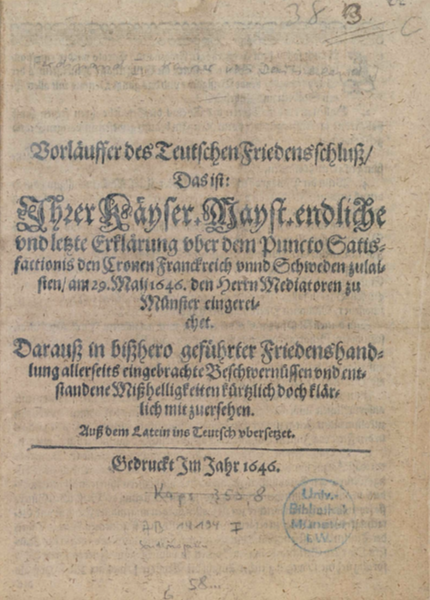Peace of Westphalia 1646-1648
Title
Peace of Westphalia 1646-1648
Content
The German Emperor's Peace Treaty with France
Instrumentum Pacis Monasteriensis
Instrumentum Pacis Monasteriensis
Preamble
[…]
And by the Mediation and Interposition of the most illustrious and most excellent Ambassador and Senator of Venice, Aloysius Contarini Knight, who for the space of five Years, or thereabouts, with great Deligence, and a Spirit intirely impartial, has been inclin'd to be a Mediator in these Affairs.
[…]1
 Vorläufer des Teuschen Friedensschluß
Vorläufer des Teuschen FriedensschlußDas ist:
Ihre Kaiserl. Mayst. endliche vnd letzte Erklärung vber dem Puncto Satisfactionis den Cronen Franckreich vnnd Schweden zulaisten/am 29 Maij 1646. den Herrn Mediatoren zu Münster eingereichet.
Draft of the German peace treaty
Which is:
His Imperial Majesty‘s final and last statement concerning the compensation to be paid to the crowns of France and Sweden/submitted to Mediators in Münster at 29 May 1646.
[...]
Der Brauch, über Vermittler zu verhandeln - auf früheren Friedenskonferenzen durchaus üblich - , wurde nur in Münster beibehalten, in Osnabrück bevorzugte man den unmittelbaren Kontakt im Gespräch. Neben den genannten Einzelgesprächen gab es hier noch den Weg, über die Friedensvermittler Vorschläge zu unterbreiten. Chigis und Contarinis Aufgabe bestand darin, die bei ihnen eingereichten Positionspapiere an den Adressaten weiterzuleiten. Sie vermieden es dabei sorgsam, etwa als Schiedsrichter aufzutreten. Dies bedeutet jedoch nicht, daß es ihnen nicht durch gelang, bisweilen allzu starre Positionen aufzuweichen, zu scharfe Formulierungen zu mildern un[d] so wichtige Änderungen vorzunehmen. Contarini hat diese Form der Verhandlungen in seinen ‚Relazione‘ auf die Schreibfreudigkeit der deutschen Juristen zurückgeführt doch entsprach sie auch den Wünschen der Mediatoren selbst, die möglichst klare und bindende Vorschläge der Parteien übermitteln wollten.“2
Translation
The negotiations took place during formal meetings or informal talks, either in the appartements of the envoys, or in those of the two mediators, Chigi and Contarini. The two mediators of peace are said to have endured over 800 of such caucus meetings [with the Protestant and Catholic delegates].
[...]
The custom to negotiate through mediators - which was common at previous peace conferences - , was maintained only in Muenster, while in Osnabrueck direct contacts in bilateral talks were preferred. Apart from caucus session, proposals were also submitted to the other side through the mediators of peace. The task of Chigi und Contarini was to remit the position-papers which they received to their addressees. They were careful to avoid to act as arbitrators. This did not mean, however, that they did not succeed in softening positions which were too strict, or formulations which were too harsh, and by doing so they achieved important modifications. In his "Relazione", Contarini traced that form of negotiations back to the love of German lawyers for written documentations, but it was also in line with the wishes of the mediators who preferred to remit clear and binding proposals to the parties.
1Text taken from http://www.pax-westphalica.de/ipmipo/indexen.html
2Haller, Bertram, Universitätsbibliothek Münster, Bibliotheksnachrichten Beiheft 1, Alvise Contarini und der Westfälische Friedenskongreß in Münster – Ausstellung vom 4. bis 30. Oktober 1982, at p. 25 et seq.)